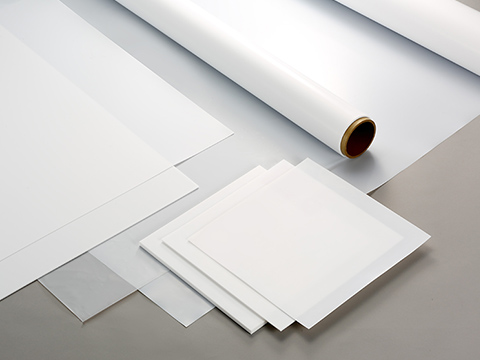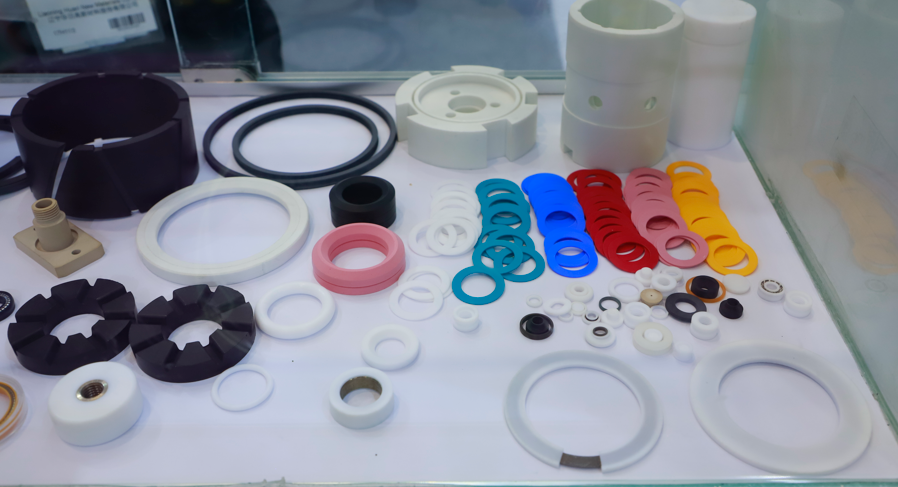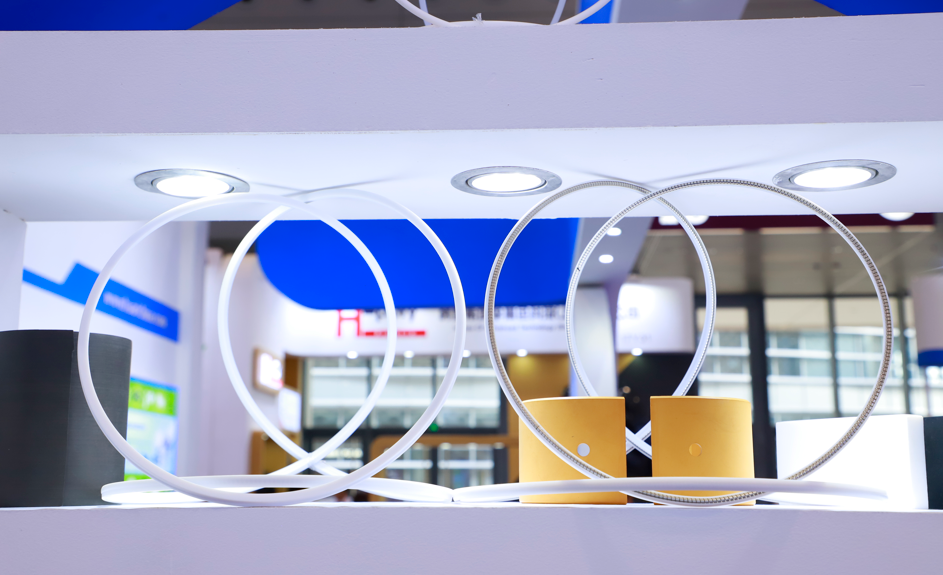Recently, CCTV focused on the new materials exhibition area of the 136th Canton Fair, and specially reported on a type of special engineering plastics - polytetrafluoroethylene (PTFE).
The picture below shows the famous "King of Plastics" - polytetrafluoroethylene (PTFE). POLYFLON PTFE

PTFE has a very wide range of applications, from non-stick pan coatings to 5G communications, aerospace, semiconductors, new energy vehicles and other fields.
The reason why non-stick pans are non-stick is that the bottom of the pan is coated with a layer of polytetrafluoroethylene (PTFE).
Nano masks containing PTFE nanofilter membranes are thinner and more transparent than ordinary medical masks.
PTFE is used in high-frequency copper-clad laminates, radio frequency cables, base station antenna filters, etc. in the field of 5G communications.
About PTFE
1. PTFE Introduction
Polytetrafluoroethylene, English name "PTFE", Chinese name "Teflon", commonly known as the "King of Plastics", is a high molecular polymer made by polymerization of tetrafluoroethylene as a monomer, which is divided into suspended resins (suspended medium particles, suspended fine particles), dispersed resins and dispersed liquids. Polytetrafluoroethylene (PTFE) has excellent weather resistance, high and low temperature resistance (can be used for a long time at -180 to 260°C), acid and alkali resistance, resistance to various organic solvents, self-lubrication and other excellent properties. In recent years, the production and consumption have increased rapidly.
2. PTFE Production method
Polytetrafluoroethylene is produced by free radical polymerization of tetrafluoroethylene. The industrial polymerization reaction is carried out by stirring in the presence of a large amount of water to disperse the reaction heat and facilitate temperature control. The polymerization is generally carried out at 40 to 80°C and 3 to 26 kgf/cm2 pressure. Inorganic persulfates and organic peroxides can be used as initiators, or redox initiation systems can be used. Each mole of tetrafluoroethylene releases 171.38 kJ of heat during polymerization. Dispersion polymerization requires the addition of perfluorinated surfactants, such as perfluorooctanoic acid or its salts.
3. PTFE typical characteristics and properties
Polytetrafluoroethylene is available in granular, fine powder and water-based dispersion forms.
Granular PTFE resin is produced by suspension polymerization in an aqueous medium with little or no dispersant. Granular PTFE resin is primarily used for molding (compression and isostatic pressing) and plunger extrusion.
PTFE fine powder is produced by controlled emulsion polymerization and is a white, fine particle. PTFE fine powder can be processed into flakes by paste extrusion or used as an additive to increase the wear resistance or friction properties of other materials.
PTFE dispersions are produced by aqueous polymerization with stirring using more dispersant. Dispersions are used for coatings and film casting.
4. PTFE Industrial chain
Upstream: tetrafluoroethylene (TFE), chlorodifluoromethane (R22), trifluoromethane (R23)
Midstream: PTFE suspension resin, PTFE dispersion resin, PTFE dispersion
Downstream: anti-corrosion lining, corrosion-resistant pipes and pipe fittings, porous filter materials, self-lubricating bearings, oil seals, sealing rings, etc.
5. PTFE Limitations
Traditional polytetrafluoroethylene has some limitations in its application, such as:
The inability to use traditional molten state processing methods and the difficulty and cost of suitable specific methods
Sensitive to creep and wear
Significant dimensional changes near the glass transition temperature
Highly corrosive and prone to toxic fumes

6. Effects of fillers and additives on the PTFE properties
The mechanical properties of PTFE can be improved by adding fillers, especially creep and wear rates. Glass fiber, bronze, steel, carbon, carbon fiber, graphite, etc. are commonly used fillers.
Glass fiber has a positive effect on the creep properties of PTFE by reducing its low and high temperatures. Glass-filled compounds perform well in oxidizing environments. Additionally, the wear characteristics of PTFE are improved.
Carbon reduces creep, increases hardness, and improves the thermal conductivity of PTFE. When combined with graphite, the wear resistance of carbon-filled compounds can be further improved. These compounds are ideal for non-lubricated applications such as piston rings in compressor cylinders. Additionally, graphite imparts excellent wear resistance to PTFE, while graphite-filled PTFE has an extremely low coefficient of friction.
Carbon fiber reduces creep, increases flexural and compression moduli, and increases hardness. Unlike glass fibers, carbon fibers are inert to hydrofluoric acid and strong bases. Carbon fiber PTFE compounds have a low coefficient of thermal expansion and high thermal conductivity. These parts are ideal for automotive parts such as shock absorbers, water pumps, etc.
Bronze-filled PTFE compounds have high thermal and electrical conductivity, which in turn makes these compounds ideal for applications where parts are subject to loads at extreme temperatures.
Other fillers incorporated into PTFE to produce specialty compounds include calcium fluoride, aluminum oxide, mica, polymer fillers. In general:
Fillers give PTFE excellent properties at low and high temperatures.
Fillers/additives increase the porosity of PTFE compounds, which affects the electrical properties - dielectric strength decreases, while dielectric constant and loss factor increase
The chemical properties depend on the type of filler used. In general, filled PTFE compounds are not as chemically sound as unfilled resins.
Fillers change the electrical and thermal conductivity of PTFE
Up to 40% (volume) of fillers can be added to PTFE without complete loss of physical properties
The effect of filler content below 5% is minimal.
7. PTFE main uses and application areas
Fluorinated thermoplastics are used only in high-performance applications related to high and low temperatures, chemical inertness, high purity, non-stick and self-lubricating properties. Higher purity grades are used in semiconductors, pharmaceuticals and other similar fields. Due to its special chemical and physical properties, polytetrafluoroethylene is widely used in the chemical, electrical/electronics, construction, building and automotive industries. Filled granular resins are found to be suitable for parts such as gaskets, shaft seals, bearings, piston rings, etc.
Automotive - O-rings, gaskets, stem seals, shaft seals, fuel hose liners, power steering and gearboxes, etc.
Chemical industry - coatings for heat exchangers, pumps, diaphragms, impellers, tanks, reaction vessels, autoclaves, containers, etc.
Electrical and electronics - electrical insulation, flexible printed circuit boards, semiconductor components.
Engineering - valve seats and plugs, bearings, non-stick surfaces, pipe coatings, accessories, valves and pump parts.
Medical - cardiovascular transplants, ligament replacements, heart patches.
Polytetrafluoroethylene is widely used as high and low temperature resistant, corrosion resistant materials, insulation materials, anti-stick coatings, etc. in atomic energy, defense, aerospace, electronics, electrical, chemical, machinery, instruments, meters, construction, textiles, metal surface treatment, pharmaceuticals, medical, textiles, food, metallurgy and smelting industries, making it an irreplaceable product.
With the rise of the global 5G market, PTFE consumption will usher in a substantial increase in high-frequency copper clad laminates, radio frequency cables, base station antenna filters and other fields. The application areas of polytetrafluoroethylene will be more extensive.

Contacts
Sales Manager Business contacts https://www.orderplastics.com
Contact: Sunny Lee
Phone: +86-18923346780
E-mail: xe001@hearplastics.com
Whatsapp:86-18923346780
Add: No. 951#, Gudu road, Sanxiang Town, Zhongshan Guangdong Provice, China
We chat
